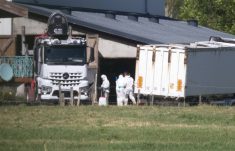By Theopolis Waters
CHICAGO, Jan 31 (Reuters) – The U.S. cattle population dropped to its lowest level in 63 years as the lingering impact of years of drought took its toll on feed costs in the first half of 2013, analysts said in response to a government yearly cattle report on Friday.
However, corn and hay prices receded as the drought eased during the last six months of 2013, which encouraged ranchers to hold back heifers for breeding, analysts and economists said.
Still, the report confirms that cattle and beef prices will hover at, or near, record highs through 2015, they said.
Read Also

U.S. livestock: Cattle fall sharply as Trump says he’s working to lower beef costs
Chicago cattle futures fell sharply on Friday after U.S. President Donald Trump said his administration was working to lower the…
“There is nothing in the report to cause us to doubt we’re going to have a lot of record prices for both cattle and beef in 2014 and 2015,” University of Missouri livestock economist Ron Plain said.
The U.S. Department of Agriculture’s annual cattle inventory report on Friday showed the U.S. cattle herd as of Jan. 1 at 98 percent of what it was a year earlier, or 87.73 million head. It was the smallest herd since 1951 and down two percent from 89.3 million head a year earlier.
Analysts, on average, expected a 1.4 percent decline.
Friday’s report is not expected to sway futures at the Chicago Mercantile Exchange on Monday, analysts and traders said.
The government’s yearly cattle report projects expectations far beyond the contract months listed by CME live cattle futures, which are affected more by near-term market fundamentals, which recently turned bearish, they said.
Economists and analysts scrutinized closely USDA’s beef cow replacement category, a clue to herd rebuilding through heifer retention, which was up two percent rather than the three percent that had been projected.
The 98 percent cattle inventory result appears bullish, although the beef cow outcome at 99 percent was slightly larger than average trade forecasts, said Allendale Inc chief strategist Rich Nelson.
“A larger cow herd than expected was offset by a smaller retention of young heifers, which rather cancel each other out. I call it a neutral report,” Nelson said.
University of Missouri’s Plain said the cattle herd decline was anticipated because it takes at least two years to produce market-ready cattle from the time heifers are retained for breeding. The industry may not reverse the downward trend in overall cattle numbers until 2016, he added.
“There are no big surprises on this report. There are signs that we’re getting to the end of this herd reduction, but we’re not moving as far as we expected,” Plain said.
He attributed the slow pace of herd rebuilding to insufficient moisture early last year that reduced the availability of grazing pastures, causing some ranchers to hold back fewer heifers than they may have wanted to.
Don Roose, president of U.S. Commodities, said that with two years before cattle come to market from heifers that are bred now, ranchers are deciding whether to move them now to take advantage of record-high cattle prices or take their chances longer term.
“Guys are pointing in that direction but not as aggressively as we had anticipated. It’s pretty attractive to sell the heifers at current prices,” he said.














